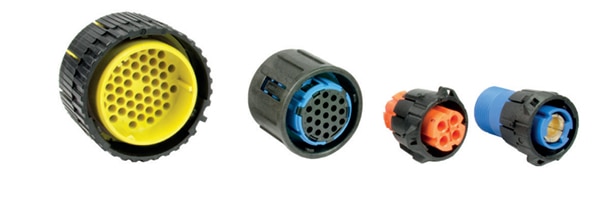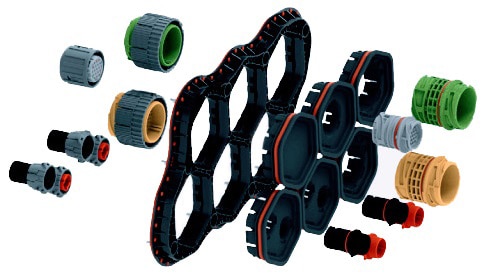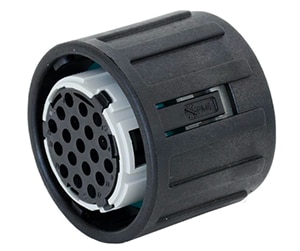Considerations for Custom Rugged Connector Solutions
Contributed By DigiKey's North American Editors
2025-02-26
A wide range of industries—transportation, chemical and discrete parts manufacturing, and shipping—require rugged components. As electronic circuitry makes its way into engines, gearboxes, and various other parts in heavy and off-road vehicles, trucks and buses, construction vehicles, and military equipment, there is a demand for rugged connectors that can withstand harsh conditions. Valued at $14.75 billion in 2023, the global market for rugged electronics—of which connectors are a part—is forecast to grow to $33.72 billion in 10 years.
Here is an overview of the factors that influence the choice of rugged connectors and how they can be customized for specific applications.
Choosing specialty rugged connectors
Connectors perform key functions in industrial equipment; they ensure that power, electronic signals, and data transmit safely and securely between various components within a product or between two or more parts.
The key factors to consider when choosing a rugged connector are:
- Its resistance to harsh conditions, which can include vibration, high or sudden loads that test impact resistance, shock, extremes in temperature, and dust.
- Conformation to standards like sealing ratings (IP67, IP69K), which ensure integrity of performance. Depending on their application, parts will likely come in contact with gasoline, diesel, hydraulic, transmission, brake fluids, and lubricants. For example, some connectors need to withstand pressure washing, which requires an IP69K rating. Tight seals prevent leakage and preserve function despite constant exposure to corrosive or harsh fluid environments.
- Electrical specifications such as voltage and current ratings, which ensure the connector can withstand expected electrical loads and fluctuations during the normal course of operation.
- Housing materials that will not compromise the integrity of the connector.
- Ease of use, which enables connectors to be quickly assembled, mated, and unmated without extended disruption of electronic signals.
ITT Cannon manufactures a range of compact and lightweight connectors for the harshest environments. Specifically, the ITT Cannon APD series (Figure 1) is a set of full-plastic, harsh environment connector solutions engineered for applications with up to 48 V/500 V and up to 240 A ratings. Options include 1 and 2-way high-power, VDE-certified 4-way high voltage solutions, and 51-way high-density connectors.
 Figure 1: The APD connector series from ITT Cannon is an all-plastic option with bayonet coupling mechanisms for tight seals. The connectors tolerate a wide range of rugged operating conditions. (Image source: ITT Cannon)
Figure 1: The APD connector series from ITT Cannon is an all-plastic option with bayonet coupling mechanisms for tight seals. The connectors tolerate a wide range of rugged operating conditions. (Image source: ITT Cannon)
The APD connector series features a bayonet coupling mechanism with a quick 120-degree turn, ensuring reliable sealing up to IP67/IP69K standards. Designed to withstand extreme temperatures ranging from -40°C to +125°C (-40°F to +257°F), they accommodate wire sizes from AWG 22 to AWG 0 and are available in both high-power and high-voltage variants. Compact, lightweight, and easy to assemble, the series offers multiple variants—1, 2, 4, 6/7, 19, 37, and 51-way —along with a comprehensive selection of accessories and tooling solutions to meet diverse application needs.
The series also includes the Modular APD Plate (Figure 2), which enables the connectors to be used in a wide range of configurations.
 Figure 2: The APD Modular Interface can be configured in a variety of ways to help reduce time invested in assembly and maintenance. (Image source: ITT Cannon)
Figure 2: The APD Modular Interface can be configured in a variety of ways to help reduce time invested in assembly and maintenance. (Image source: ITT Cannon)
The interface is meant for the effective management of connectors in cabin-to-chassis and centralized interconnect applications. The APD Plate ensures simple and fast installation, reconfiguration, and mating and unmating of APD interconnections, which is one of the ways to keep them from failing prematurely. In addition, the Modular APD Plate makes maintenance easier and uses cramped spaces more efficiently. The standardized solution can easily transport across different components and systems.
Failure mechanisms for connectors
One of the most critical factors to ensure when operating equipment under rugged conditions is that the components do not fail during normal operation. This requires a careful evaluation of the various ways in which connectors can fail, including the following:
Corrosion and contamination: Continual or frequent exposure to harsh fluids, mud, and moisture can corrode connector parts and eventually lead to attenuated signals. The plastic housing for the APD series from ITT withstands corrosion and moisture and is easy to maintain even in the harshest environmental conditions.
Vibrations and shocks: Constant jostling over unpaved roads and similar rough terrain can increase the vibrations and shocks on off-road vehicles. Road conditions are not the only factor that might contribute to wear and tear on connectors and eventual failure. The circular APD series connectors use a bayonet coupling design, which is especially suited to handle extreme vibration.
Improper assembly and maintenance: Connectors need to be assembled in precise ways, and ignoring protocols can lead to twists and bends in components that can compromise performance. Ease of assembly and dismantling helps ensure connector longevity.
Overheating due to electrical overloads: Connectors are rated to bear a certain current or voltage and withstand surges to an extent. When these limits are exceeded, meltdowns can occur, causing damage to system components and loss of signal.
Given the variety of ways in which connectors can fail, using them in complex systems requires an understanding of the specific applications and operating conditions.
Custom rugged connectors for specialty applications
At times, an extensive suite of connectors serves as the starting point for customization.
The three examples of tailored solutions from ITT Cannon illustrate the adaptability of the APD connectors to a variety of specific use cases.
For example, an engine manufacturing company needed a custom solution for large diesel engines used in ships and trains. In such equipment, the connectors ensure efficient power transmission and integration of the various systems, such as gearboxes and propellers. The primary conditions the solution had to consider included exposure to engine oils, intense vibration, and constrained space within the engine compartment. Addressing these challenges involved starting with the APD series 7-way connectors. The final solution included an additional O-ring to ensure the tightness of the seal and to improve vibration and pressure resistance. A stainless steel spring clip held the connector in place. To make efficient use of constrained space, the custom solution had half the footprint of the standard equivalent.
In a separate instance, an agricultural and construction equipment manufacturer needed a custom connector solution for a double-clutch gearbox for tractor transmissions. Such a gearbox allows for easy and smooth transitions when changing gears, a characteristic that is particularly advantageous in high-speed racing cars and tractors. One of the particular challenges for the connector system to overcome was the gearbox’s unique shape, which required a reconfiguration of the connector’s shape and form. Extreme exposure to gear oil was also a problem, as was high resistance. The final solution required six different connections: two larger 6-way power connectors based on the APD 19-way interface (Figure 3) and four smaller APD 4-way-based connectors for signal transmission. Two custom O-rings satisfied the vibration resistance requirements.
 Figure 3: The APD 19-way from ITT Cannon formed the basis for a solution for a double-clutch gearbox for tractor transmissions. (Image source: ITT Cannon)
Figure 3: The APD 19-way from ITT Cannon formed the basis for a solution for a double-clutch gearbox for tractor transmissions. (Image source: ITT Cannon)
Finally, exposure to diesel exhaust fluid in a selective catalytic reduction (SCR) pump was the primary challenge for a commercial vehicle manufacturer. The connectors needed to withstand both the corrosive environment and work in a small space. The solution included substantial form factor modifications to the APD 37-way, which was the starting point for the custom connectors. A stainless steel bracket held the connector assembly in place to ensure no loss of seal from vibration.
Conclusion
Rugged conditions can vary significantly and cover a wide range, from exposure to oil and extremes in temperature to sudden shocks and vibrations. Compounding these factors, many use cases require custom connector solutions. The APD connector series is a good place to start for a variety of applications. The large range of options is a good fit for many end uses, but is also easily customizable should specific modifications be warranted. Whether in military operations, aeronautics, trucking, or the agricultural sector, the APD connector series is meant to withstand harsh operating conditions without losing signal, data, and connection integrity.

Disclaimer: The opinions, beliefs, and viewpoints expressed by the various authors and/or forum participants on this website do not necessarily reflect the opinions, beliefs, and viewpoints of DigiKey or official policies of DigiKey.







